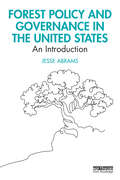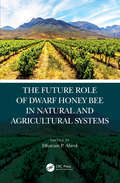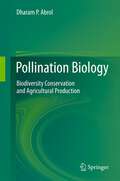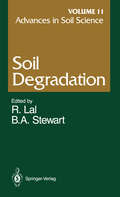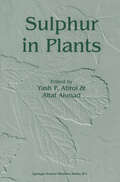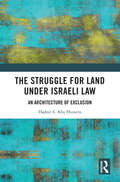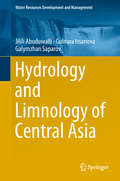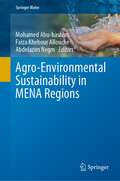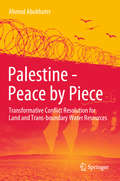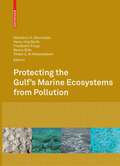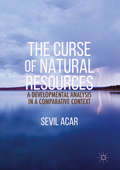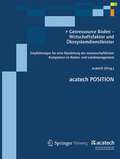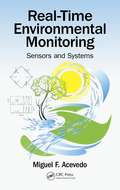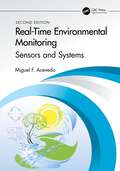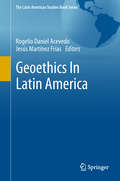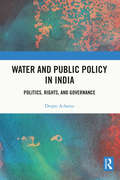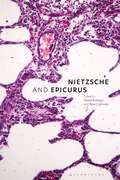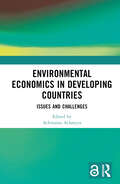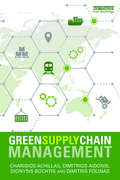- Table View
- List View
Forest Policy and Governance in the United States: An Introduction
by Jesse AbramsThis new textbook provides an up-to-date and comprehensive introduction to both the policy background and contemporary governance of forests in the United States. Starting with a history of the development of forest policies and conservation agencies, the book then explores the diversity of forest owners, users, and uses and examines emerging approaches to forest governance that cross traditional jurisdictional and property boundaries. It tackles key contemporary issues such as the forest water nexus, the conservation of threatened and endangered species, and the challenges of managing fire, insect, and disease dynamics under a changing climate. Key focal areas include the emergence of collaborative approaches to forest governance, community forest relationships, changes to corporate timberland ownership, and contemporary governance mechanisms such as certification and payments for ecosystem services. This text raises the "big questions" about the distribution of rights and responsibilities in forest management, the tensions between equity and efficiency, and how to sustain a diversity of forest values under the pressures of ecological and social complexity. Written in an accessible and engaging manner, this textbook provides a timely synthesis of both the foundations and current trends and issues in forest policy and governance in the United States with a strong emphasis on illustrative real-world cases. Forest Policy and Governance in the United States is essential reading for students in forest and natural resource policy courses and will be of great use to students in environmental governance courses. It will also be of interest to policymakers and professionals working in forest conservation and in the forest industry.
The Puppy Diaries: Living With a Dog Named Scout
by Jill AbramsonOne sparkling summer day, Jill Abramson brought home a nine-week-old golden retriever named Scout. Over the following year, as she and her husband raised their adorable new puppy, Abramson wrote a hugely popular column for The New York Times's website about the joys and challenges of training this rambunctious addition to their family. Dog-lovers from across the country inundated her with emails and letters, and the photos they sent in of their own dogs became the most visited photo album on the Times's site in 2009. Now, Abramson has gone far beyond the material in her column and written a detailed and deeply personal account of Scout's first year. Part memoir, part manual, part investigative report, The Puppy Diaries continues Abramson's intrepid reporting on all things canine. Along the way, she weighs in on such issues as breeders or shelters, adoption or rescue, raw diet or vegan, pack-leader gurus like Cesar Millan or positive-reinforcement advocates like Karen Pryor. What should you expect when a new puppy enters your life? With utterly winning stories and a wealth of practical information, The Puppy Diaries provides an essential road map for navigating the first year of your dog's life.
The Future Role of Dwarf Honey Bees in Natural and Agricultural Systems
by D. P. AbrolThe future role of dwarf honeybees in natural and agricultural systems provides multidisciplinary perspective about the different facets of dwarf honeybees. The role of dwarf honeybee Apis florea assumes utmost importance in the context of pollinator decline throughout the world threatening stability of ecosystems and global food security. Apis florea is a low land species of south Asia extending more to the west than other Asiatic Apis species. It is an important pollinator of crops in hot and dry agricultural plains. The book is first of its kind which deals in details on varied aspects of Apis florea biology, management, conservation strategies for protecting biodiversity and enhancing crop productivity. The book aims to promote a large, diverse, sustainable, and dependable bee pollinator workforce that can meet the challenge for optimizing food production well into the 21st century. Features: Apis florea provides source of livelihood in mountainous areas and marginal farmers. This book will for the first time present the beekeeping from the perspective of agricultural production and biodiversity conservation An excellent source of advanced study material for academics, researchers and students and programme planners Excellent pollinator of tropical and subtropical crops fruits vegetables etc less prone to diseases and enemies Covering the latest information on various aspects of Apis florea biology, this book brings the latest advances together in a single volume for researchers and advanced level students This book will be useful to pollination biologists, honeybee biologists in entomology departments, students, teachers, scientists of agriculture, animal behaviour, botany, conservation, biology, ecology, entomology, environmental biology, forestry, genetics, plant breeding, horticulture, toxicology, zoology, seed growers and seed agencies and shall serve as reference book for students, teachers, researchers, extension functionaries and policy planners.
The Future Role of Dwarf Honey Bees in Natural and Agricultural Systems
by Dharam P. AbrolThe future role of dwarf honeybees in natural and agricultural systems provides multidisciplinary perspective about the different facets of dwarf honeybees. The role of dwarf honeybee Apis florea assumes utmost importance in the context of pollinator decline throughout the world threatening stability of ecosystems and global food security. Apis florea is a low land species of south Asia extending more to the west than other Asiatic Apis species. It is an important pollinator of crops in hot and dry agricultural plains. The book is first of its kind which deals in details on varied aspects of Apis florea biology, management, conservation strategies for protecting biodiversity and enhancing crop productivity. The book aims to promote a large, diverse, sustainable, and dependable bee pollinator workforce that can meet the challenge for optimizing food production well into the 21st century. Features: Apis florea provides source of livelihood in mountainous areas and marginal farmers. This book will for the first time present the beekeeping from the perspective of agricultural production and biodiversity conservation An excellent source of advanced study material for academics, researchers and students and programme planners Excellent pollinator of tropical and subtropical crops fruits vegetables etc less prone to diseases and enemies Covering the latest information on various aspects of Apis florea biology, this book brings the latest advances together in a single volume for researchers and advanced level students This book will be useful to pollination biologists, honeybee biologists in entomology departments, students, teachers, scientists of agriculture, animal behaviour, botany, conservation, biology, ecology, entomology, environmental biology, forestry, genetics, plant breeding, horticulture, toxicology, zoology, seed growers and seed agencies and shall serve as reference book for students, teachers, researchers, extension functionaries and policy planners.
Pollination Biology: Biodiversity Conservation and Agricultural Production
by Dharam P. AbrolThis book has a wider approach not strictly focused on crop production compared to other books that are strictly oriented towards bees, but has a generalist approach to pollination biology. It also highlights relationships between introduced and wild pollinators and consequences of such introductions on communities of wild pollinating insects. The chapters on biochemical basis of plant-pollination interaction, pollination energetics, climate change and pollinators and pollinators as bioindicators of ecosystem functioning provide a base for future insights into pollination biology. The role of honeybees and wild bees on crop pollination, value of bee pollination, planned honeybee pollination, non-bee pollinators, safety of pollinators, pollination in cages, pollination for hybrid seed production, the problem of diseases, genetically modified plants and bees, the role of bees in improving food security and livelihoods, capacity building and awareness for pollinators are also discussed.
Advances in Soil Science: Soil Degradation Volume 11 (Advances in Soil Science #11)
by I. P. Abrol P. Alvo F. De Coninck H. Eswaran N. R. Fausey R. K. Gupta R. Lal T. J. Logan D. A. MacLeod E. McKyes C. E. Mullins K. H. Northcote G.S.V. Raghavan G. K. Sims B. A. Stewart J. M. Tisdall T. Varghese I. M. YoungThe purpose of Advances in Soil Science is to provide a forum for leading scientists to analyze and summarize the available scientific information on a subject, assessing its importance and identifying additional research needs. A wide array of subjects has been addressed by authors from many countries in the initial ten volumes of the series. The quick acceptance of the series by both authors and readers has been very gratifying and confirms our perception that a need did exist for a medium to fill the gap between the scientific journals and the comprehensive reference books. This volume is the first of the series devoted entirely to a single topic soil degradation. Future volumes will include both single-topic volumes as well as volumes containing reviews of different topics of soil science, as in the case of the first ten volumes. There are increasing concern and attention about managing natural re sources, particularly soil and water. Soil degradation is clearly one of the most pressing problems facing mankind. Although the spotlight regarding soil degradation in recent years has focused on Africa, concern about the degradation of soil and water resources is worldwide. The widespread con cern about global environmental change is also being linked to severe problems of soil degradation. Therefore, we are indeed pleased that the first volume of the series devoted to a single topic addresses such an impor tant issue. The current volume is also the first of the series involving a guest editor.
Sulphur in Plants
by Yash P. AbrolSulphur (S) plays a pivotal role in various plant growth and development processes being a constituent of sulphur-containing amino acids, cysteine and methionine, and other metabolites viz., glutathione and phytochelatins, co-factor of enzymes which contribute to stress repair and amelioration of heavy metal toxicity. Besides, a number of S-containing components are biologically active and, thus, a source for use as medicinal value. The basic global issue before the agricultural scientist and world community is to evolve cultivars and develop methodologies for efficient use of inputs to enhance agricultural productivity. This is particularly true of the developing countries which are going to see maximum rise in population with changing food demands and declining availability of land. Amongst the inputs, nutrients play a crucial role. The major requirement is for N, P and K followed by several micro-nutrients. In this context reports of world-wide S deficiency in the agricultural systems are relevant. The reasons are many. Broadly speaking reduction inS emission, use of S-free N, P and K fertilizers and higher biomass production contributed the maximum. Despite the need for sulphur as an essential plant nutrient and the substantial returns expected from its use, very little attention has been given to fill the gap between supply and demand of S.
The Struggle for Land Under Israeli Law: An Architecture of Exclusion
by Hadeel S. Abu HusseinThis book provides a comprehensive examination of land law for Arab Palestinians under Israeli law. Land is one of the core resources of human existence, development and activity. Therefore, it is also a key basis of political power and of social and economic status. Land regimes and planning regulations play a dynamic role in deciding how competing claims over resources will be resolved. According to legal geography, spatial ordering impacts legal regimes; whilst legal rules form social and human space. Through the lenses of international law, colonisation and legal geography, the book examines the land regime in Israel. More specifically, it endeavours to understand the spatial strategies adopted by Israel to organise the entire territorial expanse of the country as Jewish, while also excluding Arab Palestinian citizens of Israel and residents of East Jerusalem from the landscape. The book then details how the systematic nature and processes of marginalisation are mapped out across the civil, political and socio-economic landscape. This monograph will be of interest to international legal theorists, legal geographers, land lawyers and human rights practitioners and students; as well as to international scholars, NGOs and others focusing on the Israeli–Palestinian conflict.
The Struggle for Land Under Israeli Law: An Architecture of Exclusion
by Hadeel S. Abu HusseinThis book provides a comprehensive examination of land law for Arab Palestinians under Israeli law. Land is one of the core resources of human existence, development and activity. Therefore, it is also a key basis of political power and of social and economic status. Land regimes and planning regulations play a dynamic role in deciding how competing claims over resources will be resolved. According to legal geography, spatial ordering impacts legal regimes; whilst legal rules form social and human space. Through the lenses of international law, colonisation and legal geography, the book examines the land regime in Israel. More specifically, it endeavours to understand the spatial strategies adopted by Israel to organise the entire territorial expanse of the country as Jewish, while also excluding Arab Palestinian citizens of Israel and residents of East Jerusalem from the landscape. The book then details how the systematic nature and processes of marginalisation are mapped out across the civil, political and socio-economic landscape. This monograph will be of interest to international legal theorists, legal geographers, land lawyers and human rights practitioners and students; as well as to international scholars, NGOs and others focusing on the Israeli–Palestinian conflict.
Hydrology and Limnology of Central Asia (Water Resources Development and Management)
by Jilili Abuduwaili Gulnura Issanova Galymzhan SaparovThis book highlights the development of lake systems and water reservoirs as well as the impact of climate change on water resources in Central Asian countries. It provides information on the genesis of lake basins, physical and chemical properties of water in lakes, and the hydrological regimes (water balance and fluctuation levels) of lakes of Central Asia and Xinjiang. The book is useful for scientists and researchers whose work focuses on lakes and the use of natural resources, irrigation, hydropower and water supply, as well as for students and planners.
Agro-Environmental Sustainability in MENA Regions (Springer Water)
by Mohamed Abu-Hashim Faiza Khebour Allouche Abdelazim NegmThis book focuses on the status quo and the latest information on the water-soil-agriculture nexus in the MENA countries. It presents several case studies and applications from e.g. Morocco, Algeria, Tunisia, Egypt and Jordan, while also sharing and discussing the latest findings. The content includes a range of agriculture-related topics that focus on: water resources management, impacts of climate change, and wastewater treatment for reuse in agriculture sectors; in addition, sustainable approaches to agricultural-based industry, organic crop production, crop water requirements, and soil environment are discussed in an updated and comprehensive review. In turn, the book discusses the applications of GIS and remote sensing as a new technology for better agriculture management, as well as its use in Egypt as a representative country. In closing, it considers the implementation of an environmental information system in data-scarce MENA countries from the standpoint of the water-food nexus, and addresses the question of climate justice in the MENA region. Exploring various dimensions of MENA country-based case studies on achieving sustainable agriculture, the book offers an invaluable source of topical information for agricultural sustainability-related stakeholders in the region, researchers and graduate students alike.
Palestine - Peace by Piece: Transformative Conflict Resolution for Land and Trans-boundary Water Resources
by Ahmed AbukhaterThis book draws lessons and conclusions, based on the methodology outlined in the author's previous book, Water as a Catalyst for Peace (Routledge, 2013), and further charts the course to a more practical framework for achieving regional stability and justice. Past agreements are examined and analysed, outlining the change along the way that occurred to the land and people of Palestine. The book is written with the intention of exposing past events that led to the current situation, evaluating the current state of the conflict in light of new circumstances and the reality on the ground. Viable options are explored to seek a practical and satisfactory negotiated settlement that ensures justice and viability. In conclusion, a roadmap for future direction is proposed to achieve equitable water allocation through proper negotiation between Israel and Palestine and to ultimately settle the conflict. Water resources allocation is at the heart of this pragmatic framework and roadmap.
Protecting the Gulf's Marine Ecosystems from Pollution
by Abdulaziz H. Abuzinada Hans-Jörg Barth Friedhelm Krupp Benno Böer Thabit Zahran Al AbdessalaamThis volume reviews present sources and levels of pollution in The Gulf, assesses their causes and effects on biota and ecosystems, and identifies preventive and remedial measures reducing levels of pollution and mitigating adverse impacts. It is supported by UNESCO, Doha.
The Curse of Natural Resources: A Developmental Analysis in a Comparative Context
by Sevil AcarThis book examines the paradox that resource-rich countries often struggle to manage their resources in a way that will help their economies thrive. It looks at how a country's political regime and quality of governance can determine the degree to which it benefits - or suffers - from having natural resources, shifting away from the traditional focus on economic growth data to study the complex implications of these resources for human well-being and sustainable development. To this end, Acar examines a panel of countries in terms of the effects of their natural resources on human development and genuine saving, which is a sustainability indicator that takes into account the welfare of future generations by incorporating the changes in different kinds of capital. Acar finds that the exportation of agricultural raw materials is associated with significant deterioration in human development, while extractive resource exports, such as energy and minerals, have negative implications for genuine savings. Next, the book compares the development path of Norway before and after discovering oil, contrasting it with Sweden's development. The two countries, which followed almost identical paths until the 1970s, diverged significantly in terms of per capita income after Norway found oil.
Georessource Boden – Wirtschaftsfaktor und Ökosystemdienstleister: Empfehlungen für eine Bündelung der wissenschaftlichen Kompetenz im Boden- und Landmanagement (acatech POSITION)
by AcatechBöden bilden eine wesentliche Lebensgrundlage der Menschen. Auf ihnen wachsen Pflanzen, die als Nahrungs- und Futtermittel dienen oder als Biomasse, aus der etwa Energie gewonnen wird. Sie erfüllen auch wichtige Funktionen in unserem Ökosystem und sind als Ausgangspunkt aller biobasierten Wertschöpfungsketten ein zentraler Wirtschaftsfaktor. Der Klimawandel beeinträchtigt sowohl die Produktions- als auch Ökosystemfunktionen des Bodens. Diesen Herausforderungen muss auch die Forschung zum Boden- und Landmanagement begegnen. Die acatech POSITION erklärt, warum die deutsche Bodenforschung fächerübergreifend zusammenarbeiten sollte und benennt elf notwendige und neue Aktionsfelder dafür. acatech gibt Empfehlungen, wie die Bündelung der wissenschaftlichen Kompetenz gelingt und die Bodenfunktionen erhalten werden.
Real-Time Environmental Monitoring: Sensors and Systems
by Miguel F. AcevedoThe natural environment is complex and changes continuously at varying paces. Many, like the weather, we notice from day to day. However, patterns and rhythms examined over time give us the bigger picture. These weather statistics become climate and help us build an understanding of the patterns of change over the long term. Real-Time Environmental Monitoring: Sensors and Systems introduces the fundamentals of environmental monitoring, based on electronic sensors, instruments, and systems that allow real-time and long-term data acquisition, data-logging, and telemetry. The book details state-of-the-art technology, using a practical approach, and includes applications to many environmental and ecological systems. In the first part of the book, the author develops a story of how starting with sensors, you can progressively build more complex instruments, leading to entire systems that end with databases and web servers. In the second part, he covers a variety of sensors and systems employed to measure environmental variables in air, water, soils, vegetation canopies, and wildlife observation and tracking. This is an emerging area that is very important to some aspects of environmental assessment and compliance monitoring. Real-time monitoring approaches can facilitate the cost effective collection of data over time and, to some extent, negate the need for sample, collection, handling, and transport to a laboratory, either on-site or off-site. It provides the tools you need to develop, employ, and maintain environmental monitors.
Real-Time Environmental Monitoring: Sensors and Systems - Textbook
by Miguel F. AcevedoWritten 10 years after the publication of the first edition, this updated edition of Real-Time Environmental Monitoring: Sensors and Systems introduces the fundamentals of environmental monitoring based on electronic sensors, instruments, systems, and software that allow continuous and long-term ecological and environmental data collection. It accomplishes two objectives: explains how to use sensors for building more complex instruments, systems, and databases, and introduces a variety of sensors and systems employed to measure environmental variables in air, water, soils, vegetation canopies, and wildlife observation and tracking. This second edition is thoroughly updated in every aspect of technology and data, and each theoretical chapter is taught parallel with a hands-on application lab manual. Emphasizes real-time monitoring as an emerging area for environmental assessment and compliance and covers the fundamentals on how to develop sensors and systems Presents several entirely new topics not featured in the first edition, including remote sensing and GIS, machine learning, weather radar and satellites, groundwater monitoring, spatial analysis, and habitat monitoring Includes applications to many environmental and ecological systems Uses a practical, hands-on approach with the addition of an accompanying lab manual, which students can use to deepen their understanding, based on the author’s 40 years of academic experience Intended for upper-level undergraduate and graduate students, taking courses in civil and environmental engineering, electrical engineering, mechanical engineering, geosciences, and environmental sciences, as well as professionals working in environmental services, and researchers and academics in engineering.
Real-Time Environmental Monitoring: Sensors and Systems - Textbook
by Miguel F. AcevedoWritten 10 years after the publication of the first edition, this updated edition of Real-Time Environmental Monitoring: Sensors and Systems introduces the fundamentals of environmental monitoring based on electronic sensors, instruments, systems, and software that allow continuous and long-term ecological and environmental data collection. It accomplishes two objectives: explains how to use sensors for building more complex instruments, systems, and databases, and introduces a variety of sensors and systems employed to measure environmental variables in air, water, soils, vegetation canopies, and wildlife observation and tracking. This second edition is thoroughly updated in every aspect of technology and data, and each theoretical chapter is taught parallel with a hands-on application lab manual. Emphasizes real-time monitoring as an emerging area for environmental assessment and compliance and covers the fundamentals on how to develop sensors and systems Presents several entirely new topics not featured in the first edition, including remote sensing and GIS, machine learning, weather radar and satellites, groundwater monitoring, spatial analysis, and habitat monitoring Includes applications to many environmental and ecological systems Uses a practical, hands-on approach with the addition of an accompanying lab manual, which students can use to deepen their understanding, based on the author’s 40 years of academic experience Intended for upper-level undergraduate and graduate students, taking courses in civil and environmental engineering, electrical engineering, mechanical engineering, geosciences, and environmental sciences, as well as professionals working in environmental services, and researchers and academics in engineering.
Geoethics In Latin America (The Latin American Studies Book Series)
by Rogelio Daniel Acevedo Jesús Martínez FríasThis book studies geoethics in Latin America and offers comprehensive research on geoethics and geoeducation. Its respective chapters explore geoethics in relation to UNESCO geoparks, mining activities in Latin America, natural hazards and risk management. Geoethics is a key discipline in the field of Earth and Planetary Sciences, and not only includes scientific, technological, methodological and social-cultural aspects, but also addresses the need to consider appropriate protocols, scientific integrity issues and a code of good practice when studying the abiotic world.The position of Latin America’s recently created geoethics associations is based on protection of the environment, together with a reassurance that the balance of nature and the rights of human beings to enjoy it will be preserved.
Water and Public Policy in India: Politics, Rights, and Governance
by Deepti AcharyaThis book explores the conceptual and theoretical frameworks of Right to Water and analyzes its values in the context of water policy frameworks of the union governments in India. It uses a qualitative approach and combines critical hermeneutics with critical content analysis to introduce a new water policy framework. The volume maps the complex argumentative narrations which have emerged and evolved in the idea of Right to Water and traces the various contours and the nature of water policy texts in independent India. The book argues that the idea of Right to Water has emerged, evolved and is being argued through theoretical arguments and is shaped with the help of institutional arrangements developed at the international, regional, and national levels. Finally, the book underlines that India’s national water policies drafted respectively in 1987, 2002 and 2012, are ideal but are not embracing the values and elements of Right to Water. The volume will be of critical importance to scholars and researchers of public policy, environment, especially water policy, law, and South Asian studies.
Water and Public Policy in India: Politics, Rights, and Governance
by Deepti AcharyaThis book explores the conceptual and theoretical frameworks of Right to Water and analyzes its values in the context of water policy frameworks of the union governments in India. It uses a qualitative approach and combines critical hermeneutics with critical content analysis to introduce a new water policy framework. The volume maps the complex argumentative narrations which have emerged and evolved in the idea of Right to Water and traces the various contours and the nature of water policy texts in independent India. The book argues that the idea of Right to Water has emerged, evolved and is being argued through theoretical arguments and is shaped with the help of institutional arrangements developed at the international, regional, and national levels. Finally, the book underlines that India’s national water policies drafted respectively in 1987, 2002 and 2012, are ideal but are not embracing the values and elements of Right to Water. The volume will be of critical importance to scholars and researchers of public policy, environment, especially water policy, law, and South Asian studies.
Nietzsche and Epicurus
by Vinod Acharya Ryan J. JohnsonThis volume explores Nietzsche's decisive encounter with the ancient philosopher, Epicurus. The collected essays examine many previously unexplored and underappreciated convergences, and investigate how essential Epicurus was to Nietzsche's philosophical project through two interrelated overarching themes: nature and ethics. Uncovering the nature of Nietzsche's reception of, relation to, and movement beyond Epicurus, contributors provide insights into the relationship between suffering, health and philosophy in both thinkers; Nietzsche's stylistic analysis of Epicurus; the ethics of self-cultivation in Nietzsche's Epicureanism; practices of eating and thinking in Nietzsche and Epicurus; the temporality of Epicurean pleasure; the practice of the gay science, and Epicureanism and politics. The essays also provide creative comparisons with the Stoics, Hobbes, Mill, Guyau, Buddhism, and more. Nietzsche and Epicurus offers original and illuminating perspectives on Nietzsche's relation to the Hellenistic thinker, in whom Nietzsche saw the embodiment of the practice of philosophy as an art of existing.
Environmental Economics in Developing Countries: Issues and Challenges
by Achiransu AcharyyaThe COVID-19 pandemic has laid bare the vulnerabilities of socio-economic systems globally and exposed the risks that natural capital degradation imposes on human health, economy, and society. This book studies the environmental challenges faced by developing economies in a post-COVID-19 world. Exploring diverse case studies from South Asia and Sub-Saharan Africa, the volume discusses the impact that economic development and, recently, COVID-19 has had on the environment, ecology, and economy of these regions. It analyses nature conservation policies aimed at minimizing ecological damage arising from economic development and discusses the policy objectives of sustainable development. It also highlights the significant role that environmental economics networks have played in capacity building, framing of policies using ecological economics tools, and developing a local leadership trained in addressing local sustainability issues. An important contribution to the study of environmental economics of the Global South, the book will be of interest to students and researchers of economics, environment, development studies, development economics, environmental policies, and South Asia studies. It will also be useful for policymakers and NGOs working in this field.
Environmental Economics in Developing Countries: Issues and Challenges
by Achiransu AcharyyaThe COVID-19 pandemic has laid bare the vulnerabilities of socio-economic systems globally and exposed the risks that natural capital degradation imposes on human health, economy, and society. This book studies the environmental challenges faced by developing economies in a post-COVID-19 world. Exploring diverse case studies from South Asia and Sub-Saharan Africa, the volume discusses the impact that economic development and, recently, COVID-19 has had on the environment, ecology, and economy of these regions. It analyses nature conservation policies aimed at minimizing ecological damage arising from economic development and discusses the policy objectives of sustainable development. It also highlights the significant role that environmental economics networks have played in capacity building, framing of policies using ecological economics tools, and developing a local leadership trained in addressing local sustainability issues. An important contribution to the study of environmental economics of the Global South, the book will be of interest to students and researchers of economics, environment, development studies, development economics, environmental policies, and South Asia studies. It will also be useful for policymakers and NGOs working in this field.
Green Supply Chain Management
by Charisios Achillas Dionysis D. Bochtis Dimitrios Aidonis Dimitris FolinasToday, one of the top priorities of an organization’s modern corporate strategy is to portray itself as socially responsible and environmentally sustainable. As a focal point of sustainability initiatives, green supply chain management has emerged as a key strategy that can provide competitive advantages with significant parallel gains for company profitability. In designing a green supply chain, the intent is the adoption of comprehensive and cross-business sustainability principles, from the product conception stage to the end-of-life stage. In this context, green initiatives relate to tangible and intangible corporate benefits. Sustainability reports from numerous companies reveal that greening their supply chains has helped reduce operating cost, thus boosting effectiveness and efficiency while increasing sustainability of the business. Green Supply Chain Management provides a strategic overview of sustainable supply chain management, shedding light on the theoretical background and key principles of the topic. Specifically, this book covers various thematic areas including benefits and impact of green supply chain management; enablers and barriers on supply chain operations; inbound and outbound logistics considerations; and production, packaging and reverse logistics under the notion of "greening". The ultimate aim of this textbook is to highlight the challenges in the implementation of green supply chain management in modern companies and to provide a roadmap for decision-making in real-life cases. Combining chapter summaries and discussion questions, this book provides an accessible and student-friendly introduction to green supply change management and will be of great interest to students, scholars and practitioners in the fields of sustainable business and supply chain management.
